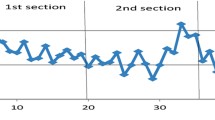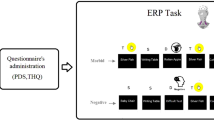Abstract
Posttraumatic stress disorder (PTSD) has been associated with an altered processing of threat-related stimuli. In particular, an attentional bias towards threat cues has been consistently found in behavioral studies. However, it is unclear whether increased attention towards threat cues translates into preferential processing as neurophysiological studies have yielded inconsistent findings. The aim of the present study was to investigate the neocortical activity related to the processing of aversive stimuli in patients with PTSD. 36 survivors of war and torture with PTSD, 21 Trauma Controls and 20 Unexposed Subjects participated in a visual evoked magnetic field study using flickering pictures of varying affective valence as stimulus material. Minimum norm source localization was carried out to estimate the distribution of sources of the evoked neuromagnetic activity in the brain. Statistical permutation analyses revealed reduced steady-state visual evoked field amplitudes over occipital areas in response to aversive pictures for PTSD patients and for Trauma Controls in comparison to unexposed subjects. Furthermore, PTSD patients showed a hyperactivation of the superior parietal cortex selectively in response to aversive stimuli, which was related to dissociative symptoms as well as to torture severity. The results indicate a different pattern of cortical activation driven by aversive stimuli depending on the experience of multiple traumatic events and PTSD. Whereas, a decreased visual processing of aversive stimuli seems to be associated with trauma exposure in general, the superior parietal activity might represent a specific process linked to the diagnosis of PTSD.





Similar content being viewed by others
Notes
The numbers of IAPS pictures were as follows. Pleasant: 2190, 2214, 2215, 2383, 2440, 2480, 2516, 2840, 2850, 5130, 5510, 5740, 7035, 7175, 7217, 7491, 7500, 7590, 7595, 7700, 8190, 5830, 5660, 4607, 2209. Neutral: 1722, 2030, 2058, 2165, 2216, 2311, 2340, 2345, 2352, 4599, 4608, 4641, 4653, 4660, 5260, 5700, 8185, 8200, 8380, 8496, 7490, 7130, 5390, 2570, 2410. Unpleasant: 2120, 2900, 3181, 3301, 6190, 6212, 6250, 6312, 6540, 6560, 6831, 6838, 9040, 9181, 9400, 9405, 9415, 9421, 9433, 9911, 6821, 3550, 3530, 2800, 2053.
References
Attias J, Bleich A, Furman V, Zinger Y (1996) Event-related potentials in post-traumatic stress disorder of combat origin. Biol Psychiatry 40:373–381
Basoglu M, Jaranson J, Mollica R, Kastrup M (2001) Torture and mental health: a research overview. In: Garrity T, Keane T, Tuma F (eds) The mental health consequences of torture. Plenum, New York, pp 35–62
Berg P, Scherg M (1994) A multiple source approach to the correction of eye artifacts. Electroencephalogr Clin Neurophysiol 90:229–241
Bickford RG, Fleming N, Billinger T (1971) Compression of EEG data. Trans Am Neurol Assoc 96:118–122
Blake DD, Weathers FW, Nagy LM, Kaloupek DG, Gusman FD, Charney DS, Keane TM (1995) The development of a Clinician-Administered PTSD Scale. J Trauma Stress 8:75–90
Bleich AV, Attias J, Furman V (1996) Effect of repeated visual traumatic stimuli on the event related P3 brain potential in post-traumatic stress disorder. Int J Neurosci 85:45–55
Bradley MM, Lang PJ (1994) Measuring emotion: the Self-Assessment Manikin and the Semantic Differential. J Behav Ther Exp Psychiatry 25:49–59
Buckley TC, Blanchard EB, Neill WT (2000) Information processing and PTSD: a review of the empirical literature. Clin Psychol Rev 20:1041–1065
Cabeza R (2008) Role of parietal regions in episodic memory retrieval: the dual attentional processes hypothesis. Neuropsychologia 46:1813–1827
Campbell TA (2007) Psychological assessment, diagnosis, and treatment of torture survivors: a review. Clin Psychol Rev 27:628–641
Carlson EB, Rosser-Hogan R (1994) Cross-cultural response to trauma: a study of traumatic experiences and posttraumatic symptoms in Cambodian refugees. J Trauma Stress 7:43–58
Clark CR, McFarlane AC, Morris P, Weber DL, Sonkkilla C, Shaw M, Marcina J, Tochon-Danguy HJ, Egan GF (2003) Cerebral function in posttraumatic stress disorder during verbal working memory updating: a positron emission tomography study. Biol Psychiatry 53:474–481
Corbetta M, Shulman GL, Miezin FM, Petersen SE (1995) Superior parietal cortex activation during spatial attention shifts and visual feature conjunction. Science 270:802–805
Ehlers A, Clark DM (2000) A cognitive model of posttraumatic stress disorder. Behav Res Ther 38:319–345
Ehlers CL, Hurst S, Phillips E, Gilder DA, Dixon M, Gross A, Lau P, Yehuda R (2006) Electrophysiological responses to affective stimuli in American Indians experiencing trauma with and without PTSD. Ann NY Acad Sci 1071:125–136
Felmingham KL, Bryant RA, Gordon E (2003) Processing angry and neutral faces in post-traumatic stress disorder: an event-related potentials study. NeuroReport 14:777–780
Gehricke J, Shapiro D (2000) Reduced facial expression and social context in major depression: discrepancies between facial muscle activity and self-reported emotion. Psychiatry Res 95:157–167
Hamalainen MS, Ilmoniemi RJ (1994) Interpreting magnetic fields of the brain: minimum norm estimates. Med Biol Eng Comput 32:35–42
Han S, Jiang Y (2004) The parietal cortex and attentional modulations of activities of the visual cortex. Neuroreport 15:2275–2280
Hauk O (2004) Keep it simple: a case for using classical minimum norm estimation in the analysis of EEG and MEG data. Neuroimage 21:1612–1621
Hillyard SA, Anllo-Vento L (1998) Event-related brain potentials in the study of visual selective attention. Proc Natl Acad Sci USA 95:781–787
Holmes A, Nielsen MK, Green S (2008) Effects of anxiety on the processing of fearful and happy faces: an event-related potential study. Biol Psychol 77:159–173
Irle E, Lange C, Weniger G, Sachsse U (2007) Size abnormalities of the superior parietal cortices are related to dissociation in borderline personality disorder. Psychiatry Res 156:139–149
Jensen O, Vanni S (2002) A new method to identify multiple sources of oscillatory activity from magnetoencephalographic data. Neuroimage 15:568–574
Junghöfer M, Bradley MM, Elbert TR, Lang PJ (2001) Fleeting images: a new look at early emotion discrimination. Psychophysiology 38:175–178
Junghöfer M, Peyk P (2004) Analyse und Visualisierung von Hirnstrom- und Hirnmagnetfeld-Messungen [analysis of electrical potentials and magnetic fields of the brain]. Matlab Select 2:24–28. EMEGS software is freely available at http://www.emegs.org/
Junghofer M, Sabatinelli D, Bradley MM, Schupp HT, Elbert TR, Lang PJ (2006) Fleeting images: rapid affect discrimination in the visual cortex. NeuroReport 17:225–229
Karl A, Malta LS, Maercker A (2006) Meta-analytic review of event-related potential studies in post-traumatic stress disorder. Biol Psychol 71:123–147
Karniski W, Blair RC, Snider AD (1994) An exact statistical method for comparing topographic maps, with any number of subjects and electrodes. Brain Topogr 6:203–210
Keil A, Gruber T, Muller MM, Moratti S, Stolarova M, Bradley MM, Lang PJ (2003) Early modulation of visual perception by emotional arousal: evidence from steady-state visual evoked brain potentials. Cogn Affect Behav Neurosci 3:195–206
Keil A, Stolarova M, Heim S, Gruber T, Müller MM (2003) Temporal stability of high-frequency brain oscillations in the human EEG. Brain Topogr 16:101–110
Kemp AH, Gray MA, Eide P, Silberstein RB, Nathan PJ (2002) Steady-state visually evoked potential topography during processing of emotional valence in healthy subjects. NeuroImage 17:1684–1692
Kounios J, Litz B, Kaloupek D, Riggs D, Knight J, Weathers F, Anderson JE, Keane T (1997) Electrophysiology of combat-related PTSD. Ann NY Acad Sci 821:504–507
Lang PJ, Bradley MM, Cuthbert BN (1998) Emotion, motivation, and anxiety: brain mechanisms and psychophysiology. Biol Psychiatry 44:1248–1263
Lang PJ, Bradley MM, Cuthbert BN (2005) International Affective Picture System (IAPS): affective ratings of pictures and instruction manual. University of Florida, Gainesville
Lang PJ, Bradley MM, Cuthbert BN (1997) Motivated attention: affect, activation and action. In: Lang PJ, Simons RF, Balaban MT (eds) Attention and orienting: sensory and motivational processes. Erlbaum, Mahwah
Lanius RA, Williamson PC, Bluhm RL, Densmore M, Boksman K, Neufeld RW, Gati JS, Menon RS (2005) Functional connectivity of dissociative responses in posttraumatic stress disorder: a functional magnetic resonance imaging investigation. Biol Psychiatry 57:873–884
Lanius RA, Williamson PC, Boksman K, Densmore M, Gupta M, Neufeld RW, Gati JS, Menon RS (2002) Brain activation during script-driven imagery induced dissociative responses in PTSD: a functional magnetic resonance imaging investigation. Biol Psychiatry 52:305–311
Ludbrook J, Dudley H (1998) Why permutation tests are superior to t and F tests in biomedical research. The American Statistician 52:127–132
McNally RJ, Clancy SA, Schacter DL, Pitman RK (2000) Cognitive processing of trauma cues in adults reporting repressed, recovered, or continuous memories of childhood sexual abuse. J Abnorm Psychol 109:355–359
McNally RJ, Kaspi SP, Riemann BC, Zeitlin SB (1990) Selective processing of threat cues in posttraumatic stress disorder. J Abnorm Psychol 99:398–402
Metzger LJ, Orr SP, Lasko NB, Pitman RK (1997) Auditory event-related potentials to tone stimuli in combat-related posttraumatic stress disorder. Biol Psychiatry 42:1006–1015
Moratti S, Keil A, Stolarova M (2004) Motivated attention in emotional picture processing is reflected by activity modulation in cortical attention networks. Neuroimage 21:954–964
Moratti S, Rubio G, Campo P, Keil A, Ortiz T (2008) Hypofunction of right temporoparietal cortex during emotional arousal in depression. Arch Gen Psychiatry 65:532–541
Ray WJ, Odenwald M, Neuner F, Schauer M, Ruf M, Wienbruch C, Rockstroh B, Elbert T (2006) Decoupling neural networks from reality: dissociative experiences in torture victims are reflected in abnormal brain waves in left frontal cortex. Psychol Sci 17:825–829
Regan D (1989) Human Brain Electrophysiology: Evoked Potentials and Evoked Magnetic Fields in Science and Medicine. Elsevier, New York
Rief W, Hiller W (2003) A new approach to the assessment of the treatment effects of somatoform disorders. Psychosomatics 44:492–498
Rossignol M, Philippot P, Douilliez C, Crommelinck M, Campanella S (2005) The perception of fearful and happy facial expression is modulated by anxiety: an event-related potential study. Neurosci Lett 377:115–120
Sheehan DV, Lecrubier Y, Sheehan KH, Amorim P, Janavs J, Weiller E, Hergueta T, Baker R, Dunbar GC (1998) The Mini-International Neuropsychiatric Interview (M.I.N.I.): the development and validation of a structured diagnostic psychiatric interview for DSM-IV and ICD-10. J Clin Psychiatry 59(Suppl 20):22–33 quiz 34–57
Sloan DM, Strauss ME, Quirk SW, Sajatovic M (1997) Subjective and expressive emotional responses in depression. J Affect Disord 46:135–141
Sloan DM, Strauss ME, Wisner KL (2001) Diminished response to pleasant stimuli by depressed women. J Abnorm Psychol 110:488–493
vivo (2008) http://www.vivo.org
Williams JB (1988) A structured interview guide for the Hamilton Depression Rating Scale. Arch Gen Psychiatry 45:742–747
Acknowledgments
We are grateful to all subjects who took part in the study. Research was supported by the Deutsche Forschungsgemeinschaft (DFG) and the European Refugee Fund (EFF). The authors would like to thank Heike Riedke for logistical support, the outpatient clinic staff for clinical support, Ursula Lommen for helping with MEG data acquisition, Stephan Moratti and Christian Wienbruch for technical advice, Sonja Haas and Steivan Pinösch for helping with entry and administration of data, and Katy Robjant for editing.
Conflict of interest statement
Authors declare they have no conflict of interest. The corresponding author had full access to all of the data in the study and takes responsibility for the integrity of the data and the accuracy of the data analysis.
Author information
Authors and Affiliations
Corresponding author
Rights and permissions
About this article
Cite this article
Catani, C., Adenauer, H., Keil, J. et al. Pattern of cortical activation during processing of aversive stimuli in traumatized survivors of war and torture. Eur Arch Psychiatry Clin Neurosci 259, 340–351 (2009). https://doi.org/10.1007/s00406-009-0006-4
Received:
Accepted:
Published:
Issue Date:
DOI: https://doi.org/10.1007/s00406-009-0006-4




